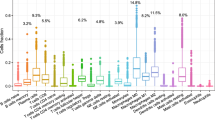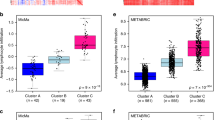Abstract
Purpose
There is a growing body of literature demonstrating that immune-related expression signatures predict breast cancer prognosis and chemo-/targeted-therapy responsiveness. However, it is unclear whether these signatures correlate with each other or represent distinct immune-related signals.
Methods
We evaluated 57 published immune-related expression signatures in four public breast cancer datasets totaling 3295 samples. For each dataset, we used consensus clustering to group signatures together based on their co-expression pattern. Signatures that were in the same consensus cluster across all four datasets were used to define immune modules. Tumors were then classified into immune subtypes based on their module scores using consensus clustering. Survival analysis was conducted using Cox proportional hazards modeling.
Results
Consensus clustering consistently yields four distinct co-expression modules across the datasets. These modules appear to represent distinct immune components and signals, where constituent signatures relate to (1) T-cells and/or B-cells (T/B-cell), (2) interferon (IFN), (3) transforming growth factor beta (TGFB), and (4) core–serum response, dendritic cells, and/or macrophages (CSR). Subtyping of tumors based on these co-expression modules consistently yields subsets that fall into five major immune subtypes: T/B-cell/IFN High, IFN/CSR High, CSR High, TGFB High, and Immune Low. Basal and/or triple-negative breast cancer patients with CSR High tumors have significantly worse outcome relative to those within the T/B-cell/IFN High subtype.
Conclusion
Our exploratory study identified four distinct immune co-expression modules (T/B-cell, IFN, TGFB, or CSR) from published immune signatures. Using these modules, we identified five immune subtypes with significant outcome differences in basal breast cancers.




Similar content being viewed by others
References
Campbell MJ et al (2013) The prognostic implications of macrophages expressing proliferating cell nuclear antigen in breast cancer depend on immune context. PLoS ONE 8(10):e79114
Bindea G et al (2013) Spatiotemporal dynamics of intratumoral immune cells reveal the immune landscape in human cancer. Immunity 39(4):782–795
Loi S (2013) Tumor-infiltrating lymphocytes, breast cancer subtypes and therapeutic efficacy. Oncoimmunology 2(7):e24720
Salgado R et al (2015) The evaluation of tumor-infiltrating lymphocytes (TILs) in breast cancer: recommendations by an International TILs Working Group 2014. Ann Oncol 26(2):259–271
Lee N et al (2016) Tumour-infiltrating lymphocytes in melanoma prognosis and cancer immunotherapy. Pathology 48(2):177–187
Rody A et al (2011) A clinically relevant gene signature in triple negative and basal-like breast cancer. Breast Cancer Res 13(5):R97
Pichler R et al (2016) Tumor-infiltrating immune cell subpopulations influence the oncologic outcome after intravesical bacillus calmette-guerin therapy in bladder cancer. Oncotarget 7(26):39916–39930
DeNardo DG et al (2011) Leukocyte complexity predicts breast cancer survival and functionally regulates response to chemotherapy. Cancer Discov 1(1):54–67
Denkert C et al (2015) Tumor-infiltrating lymphocytes and response to neoadjuvant chemotherapy with or without carboplatin in human epidermal growth factor receptor 2-positive and triple-negative primary breast cancers. J Clin Oncol 33(9):983–991
Gianni L et al (2005) Gene expression profiles in paraffin-embedded core biopsy tissue predict response to chemotherapy in women with locally advanced breast cancer. J Clin Oncol 23(29):7265–7277
Stagg J, Andre F, Loi S (2012) Immunomodulation via chemotherapy and targeted therapy: a new paradigm in breast cancer therapy? Breast Care (Basel) 7(4):267–272
Hatzis C et al (2011) A genomic predictor of response and survival following taxane-anthracycline chemotherapy for invasive breast cancer. JAMA 305(18):1873–1881
Emens LA (2012) Breast cancer immunobiology driving immunotherapy: vaccines and immune checkpoint blockade. Expert Rev Anticancer Ther 12(12):1597–1611
Chaganty BK et al (2016) Trastuzumab upregulates expression of HLA-ABC and T cell costimulatory molecules through engagement of natural killer cells and stimulation of IFNgamma secretion. Oncoimmunology 5(4):e1100790
Knutson KL et al (2016) Improved survival of HER2+ breast cancer patients treated with trastuzumab and chemotherapy is associated with host antibody immunity against the HER2 intracellular domain. Cancer Res 76(13):3702–3710
Calabro L et al (2010) Clinical studies with anti-CTLA-4 antibodies in non-melanoma indications. Semin Oncol 37(5):460–467
Criscitiello C, Curigliano G (2013) Immunotherapeutics for breast cancer. Curr Opin Oncol 25(6):602–608
Shumway NM et al (2009) Therapeutic breast cancer vaccines: a new strategy for early-stage disease. BioDrugs 23(5):277–287
Bild AH et al (2006) Oncogenic pathway signatures in human cancers as a guide to targeted therapies. Nature 439(7074):353–357
Ernst B, Anderson KS (2015) Immunotherapy for the treatment of breast cancer. Curr Oncol Rep 17(2):5
Roepman P et al (2009) An immune response enriched 72-gene prognostic profile for early-stage non-small-cell lung cancer. Clin Cancer Res 15(1):284–290
Sharma P et al (2011) Novel cancer immunotherapy agents with survival benefit: recent successes and next steps. Nat Rev Cancer 11(11):805–812
Wang ZX et al (2014) Adoptive cellular immunotherapy for the treatment of patients with breast cancer: a meta-analysis. Cytotherapy 16(7):934–945
Lum LG et al (2015) Targeted T-cell therapy in stage IV breast cancer: a phase I clinical trial. Clin Cancer Res 21(10):2305–2314
Festino L et al (2016) Cancer treatment with anti-PD-1/PD-L1 agents: is PD-L1 expression a biomarker for patient selection? Drugs 76(9):925–945
Aguiar PN Jr et al (2016) The role of PD-L1 expression as a predictive biomarker in advanced non-small-cell lung cancer: a network meta-analysis. Immunotherapy 8(4):479–488
Chen PL et al (2016) Analysis of immune signatures in longitudinal tumor samples yields insight into biomarkers of response and mechanisms of resistance to immune checkpoint blockade. Cancer Discov 6(8):827–837
Wolf DM et al (2014) Gene co-expression modules as clinically relevant hallmarks of breast cancer diversity. PLoS ONE 9(2):e88309
Ciriello G et al (2015) Comprehensive molecular portraits of invasive lobular breast cancer. Cell 163(2):506–519
Curtis C et al (2012) The genomic and transcriptomic architecture of 2,000 breast tumours reveals novel subgroups. Nature 486(7403):346–352
Minn AJ et al (2007) Lung metastasis genes couple breast tumor size and metastatic spread. Proc Natl Acad Sci USA 104(16):6740–6745
Teschendorff AE et al (2010) Improved prognostic classification of breast cancer defined by antagonistic activation patterns of immune response pathway modules. BMC Cancer 10:604
Fan C et al (2011) Building prognostic models for breast cancer patients using clinical variables and hundreds of gene expression signatures. BMC Med Genom 4:3
Parker JS et al (2009) Supervised risk predictor of breast cancer based on intrinsic subtypes. J Clin Oncol 27(8):1160–1167
Newman AM et al (2015) Robust enumeration of cell subsets from tissue expression profiles. Nat Methods 12(5):453–457
Acknowledgements
This study was funded in part by NCI grant U01 CA196406 and the Breast Cancer Research Foundation (BCRF).
Author information
Authors and Affiliations
Corresponding author
Ethics declarations
Conflict of interest
None.
Electronic supplementary material
Below is the link to the electronic supplementary material.
10549_2016_4041_MOESM3_ESM.pdf
Supplementary Figure 1. Association between individual signatures and recurrence-free survival within each intrinsic subtypes of the METABRIC cohort. Subtypes are arranged along the columns; and signatures are arranged along the row. Heatmap color indicates whether a given signature is significantly associated with RFS after adjustment for multiple testing using the BH FDR correction (red: associated with increased hazard; blue: associated with decreased hazard, gray: BH FDR corrected p > 0.05) (PDF 118 kb)
10549_2016_4041_MOESM4_ESM.pdf
Supplementary Figure 2. Heatmaps showing patient immune subtypes for the remaining three datasets considered in our study: 2a-TCGA; 2b-pooled triple negative; 2c-EMC344 (PDF 530 kb)
10549_2016_4041_MOESM5_ESM.pdf
Supplementary Figure 3. Bar plots showing the percentage of each immune subtype in each intrinsic or receptor subtype for each dataset: 3a-METABRIC; 3b-TCGA; 3c-EMC344 (PDF 69 kb)
10549_2016_4041_MOESM6_ESM.pdf
Supplementary Figure 4. Bar plots showing the percentage of each intrinsic or receptor subtype in each immune subtype for each dataset: 4a-METABRIC; 4b-TCGA; 4c-EMC344 (PDF 116 kb)
10549_2016_4041_MOESM7_ESM.pdf
Supplementary Figure 5. Gene overlap between signatures. Signatures are arranged in order by their co-expression module assignment along both x- and y- axis; and the heatmap color intensity reflects the fraction of genes in the y-axis signature that is also in the x-axis signature. The row annotation reflects module assignment (TGFB: hotpink, a lymphocyte: T/B-cell: red, IFN: black and CSR: cyan) (PDF 295 kb)
Rights and permissions
About this article
Cite this article
Amara, D., Wolf, D.M., van ’t Veer, L. et al. Co-expression modules identified from published immune signatures reveal five distinct immune subtypes in breast cancer. Breast Cancer Res Treat 161, 41–50 (2017). https://doi.org/10.1007/s10549-016-4041-3
Received:
Accepted:
Published:
Issue Date:
DOI: https://doi.org/10.1007/s10549-016-4041-3




